Module 3 Heroes Unit 2课件(共31张PPT) 2024-2025学年外研版(2024)英语九年级上册
文档属性
| 名称 | Module 3 Heroes Unit 2课件(共31张PPT) 2024-2025学年外研版(2024)英语九年级上册 |
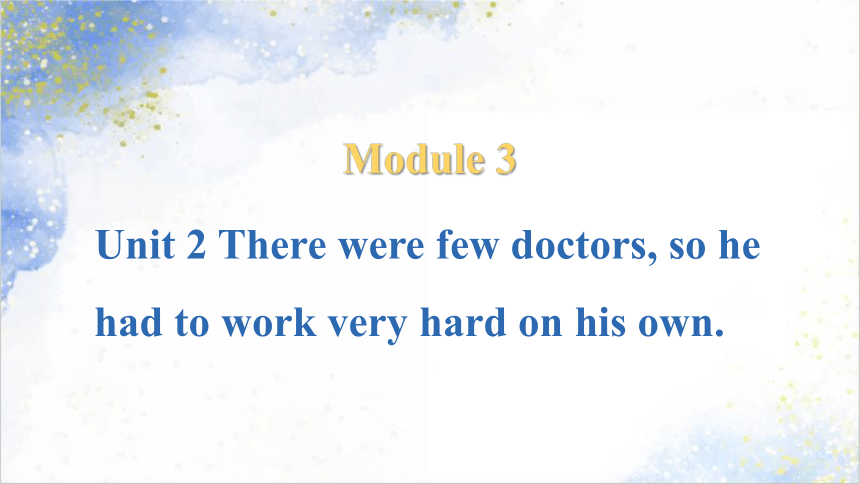
|
|
| 格式 | pptx | ||
| 文件大小 | 2.3MB | ||
| 资源类型 | 教案 | ||
| 版本资源 | 外研版 | ||
| 科目 | 英语 | ||
| 更新时间 | 2024-11-10 03:18:24 | ||
图片预览

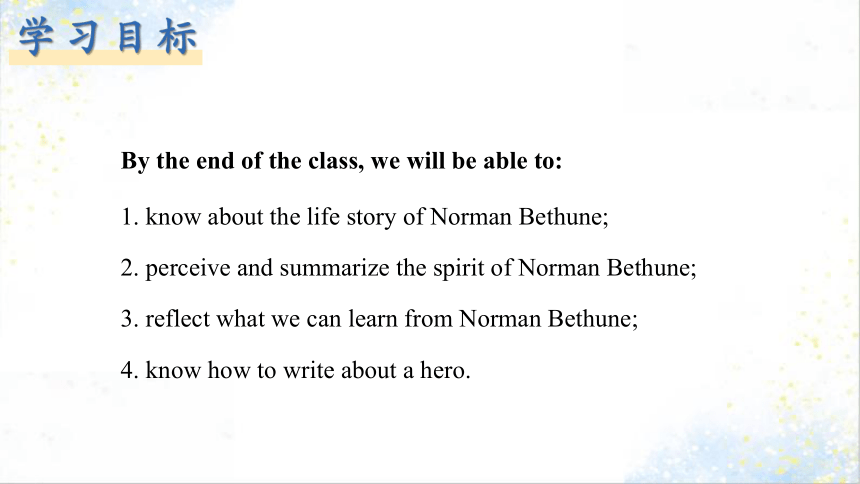


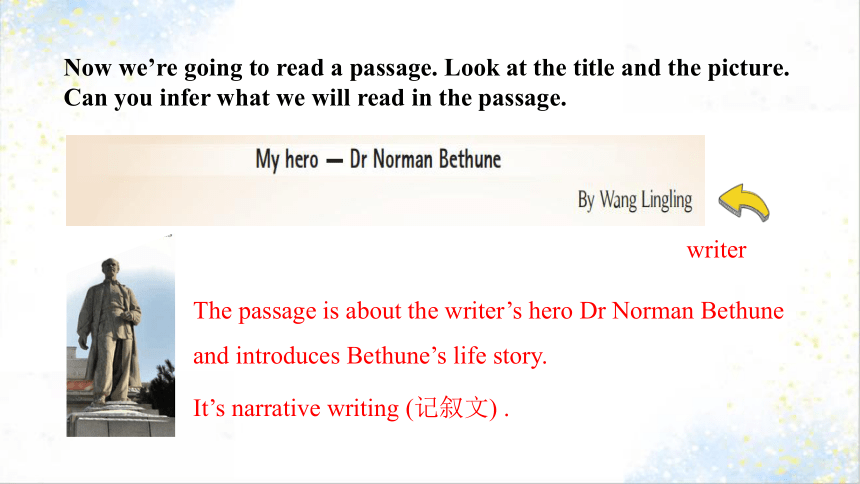
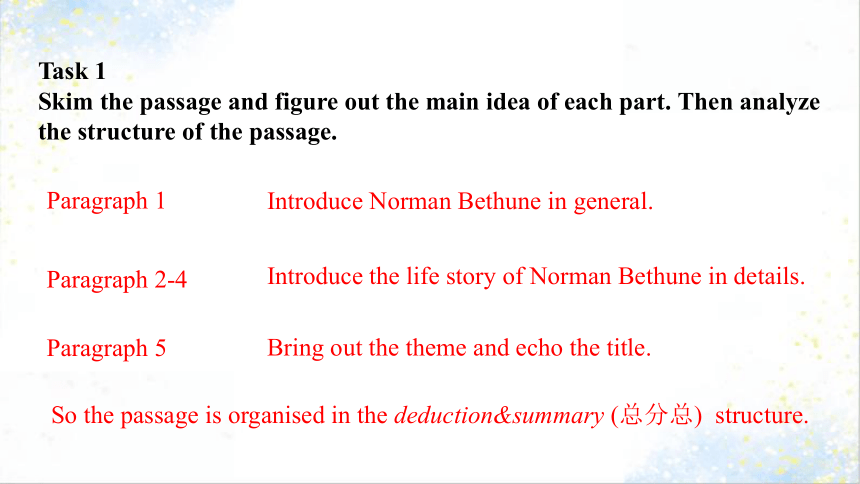



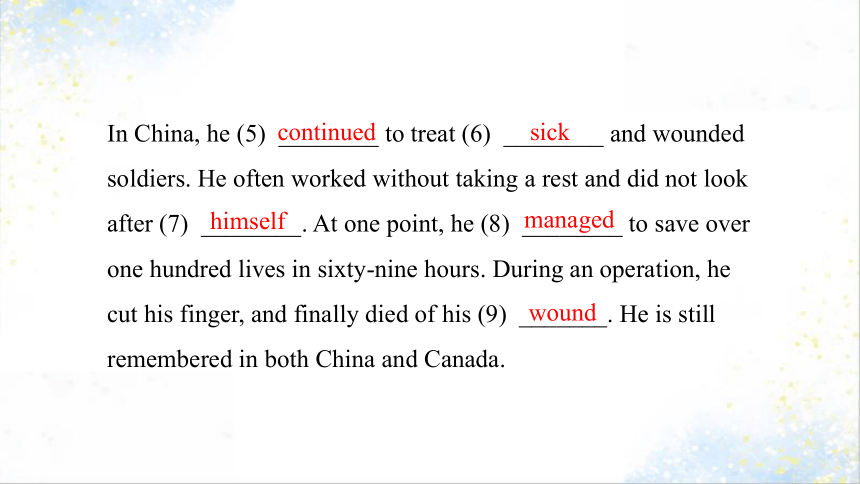

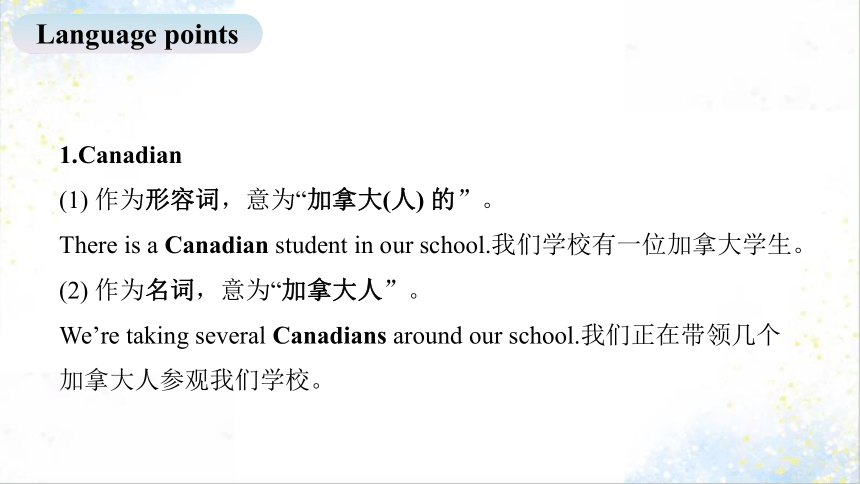
文档简介
(共31张PPT)
Module 3
Unit 2 There were few doctors, so he had to work very hard on his own.
1. know about the life story of Norman Bethune;
2. perceive and summarize the spirit of Norman Bethune;
3. reflect what we can learn from Norman Bethune;
4. know how to write about a hero.
By the end of the class, we will be able to:
学习目标
Look at the following pictures. Do you know who the man is What was he doing in the last two pictures
He’s Norman Bethune, a great doctor and hero. He was doing surgery in the last two pictures.
新课讲授
Do you know anything about Dr Bethune Why do we Chinese think highly of him so much Work in pairs to discuss and share your opinions. Use the words in the box to help you.
Canadian doctor hospital sick soldier treat war wound
Dr Bethune is a Canadian doctor with great medical skills.
Dr Bethune came to China to help treat sick and wounded soldiers during the war.
Sample:
Pair Work
Now we’re going to read a passage. Look at the title and the picture. Can you infer what we will read in the passage.
writer
The passage is about the writer’s hero Dr Norman Bethune and introduces Bethune’s life story.
It’s narrative writing (记叙文) .
Task 1
Skim the passage and figure out the main idea of each part. Then analyze the structure of the passage.
Paragraph 5
Introduce the life story of Norman Bethune in details.
Introduce Norman Bethune in general.
Bring out the theme and echo the title.
Paragraph 1
Paragraph 2-4
So the passage is organised in the deduction&summary (总分总) structure.
Task 2
Read Para2-4 carefully and number the events about Norman Bethune in the order they happened.
a. came to China
b. wrote books about ways of treating the sick in China
c. was born in 1890
d. invented medical tools to use outside hospital
e. died
f. went to treat the wounded soldiers in Spain
4
5
1
3
6
2
So the life story of Bethune is narrated in Chronological Order(时间顺序) .
Task 3
Complete the following chart according to the Para2-4.
in 1890
was born in Canada
in 1916
became
________
went to Spain to
_______________
in 1936
developed __________
____________________;
invented_________________.
More lives were saved.
in 1938
came to China to
_______________
developed ______________;
wrote books so that ______________________________________;
worked hard without
__________________________.
in 1939
died because
______________________________
a doctor
treat the wounded soldiers
new ways of taking care of the sick
special medical tools
help treat the wounded
training courses
they could learn about how he treated the sick
resting or taking care of himself
he cut his finger during an operation
Task 4
Complete the summary with the correct form of the words in the box.
Canadian continue himself invention manage sick tool war wound
Norman Bethune was (1) _________, but he is one of the most famous heroes in China. During the (2) ______ in Spain, he treated the wounded soldiers there. He invented special (3) _______ to use outside hospitals. His (4) ________ saved many lives.
Canadian
war
tools
inventions
In China, he (5) ________ to treat (6) ________ and wounded soldiers. He often worked without taking a rest and did not look after (7) ________. At one point, he (8) ________ to save over one hundred lives in sixty-nine hours. During an operation, he cut his finger, and finally died of his (9) _______. He is still remembered in both China and Canada.
continued
sick
himself
managed
wound
1. What do you think of Dr Norman Bethune after reading the passage
2. What can we learn from the life story of Dr Norman Bethune
Think and Share
1.Canadian
(1) 作为形容词,意为“加拿大(人) 的”。
There is a Canadian student in our school.我们学校有一位加拿大学生。
(2) 作为名词,意为“加拿大人”。
We’re taking several Canadians around our school.我们正在带领几个加拿大人参观我们学校。
Language points
2.sick
(1) 作为形容词,意为“(感到) 不适的;生病的”,既可以作表语也可以作定语。其同义词为ill, 但是它一般只作表语形容词,意为“生病的”,可以与sick互换。而作为定语形容词,其意义有些变化,意为“坏的;邪恶的等”。
Although the mother is ill/sick,she has to look after her sick son. 虽然妈妈生病了,但是她不得不照顾生病的儿子。
Mr Smith is an ill man.Almost everyone is afraid of him.史密斯先生是一个邪恶的人,几乎每个人都害怕他。
(2) 其名词为sickness,意为“疾病”,其同义词为illness.
The young woman suffered serious sickness.那位年轻的女士遭遇了严重的疾病。
3.treat
(1) 作为动词,意为“医治;治疗”。常用于treat sb. for sth.,意为“给某人治疗某种疾病”。The doctor treated the patient for lung cancer.医生给病人治疗肺癌。
(2) 作为动词,还有“招待;款待;对待”的意思。常用于以下表达中:①treat sb. as... “把某人当做/视作……”We treated him as our hero.我们把他当做我们的英雄来对待。②treat sb.to sth. “请客款待某人”The young man treated all his friends to a big dinner.那个年轻人请朋友们吃大餐。
(3) 其名词为treatment,意为“治疗;疗法;款待;对待”。
The patient has to go to hospital for treatment every week.
那个病人每周都不得不去医院接受治疗。
4.wound
(1) 作为名词,意为“伤;伤口”。
The doctor is cleaning the soldier’s wound in the arm.医生正在清理士兵身上的伤口。
(2) 作为动词,意为“受伤;负伤”。
The soldier was wounded in the war.那位士兵在战争中负了伤。
(3) 其形容词为wounded,意为“受伤的”。常用the wounded表示伤员。
Dr.Norman Bethune cured many wounded soldiers.诺曼白求恩医生治愈了很多受伤的士兵.
5.realise
(1) 作为及物动词,意为“了解;意识到”。其美式写法为realize。
I didn’t realise/realize the importance of learning a second language until I started work.我直到上班后才意识到学习第二门语言的重要性。
(2) 作为动词,还有“实现;完成”的意思。
Study hard from now on, you are sure to realise your dream in the future.
从现在开始好好学习,将来你一定会实现自己的梦想。
6.dying的用法
(1) 作为形容词,意为“垂死的;即将死亡的”。
The doctors and the nurses are trying their best to save the dying patient.医生和护士们正在尽全力去挽救那个奄奄一息的病人的生命。
(2) 形容词dead,意为“死亡的;去世的”。
Look!There are many dead fish in the river.看!河里有很多死鱼。
(3) 名词death,意为“死;死亡”。
The death of the pet dog made the little girl very sad.
宠物狗的死让那个小女孩儿非常难过。
(4) 动词die,意为“死亡”。常用于以下表达中:
①die for “为……而死”,表示为某种目的而献身。
The soldiers died for the country.士兵们为了国家而死。
②die from “死于……”,常指因外部原因造成的死亡,如事故、外伤等。
The old man died from a car accident yesterday.那个老人昨天死于交通事故。
③die of “死于……”,常指因疾病、年老等身体内部原因而造成的死亡。
The old man died of heart disease yesterday.那个老人昨天死于心脏病。
④die out “灭绝”,表示物种灭绝。
Many animals are in danger of dying out.很多动物现在面临灭绝的危险。
7.care
(1) 作为动词,意为“照顾;照料”。常用于以下表达中:
①care for “照看;照料”
The nurse cared for the patient very well.那个护士把病人照顾地很好。
②care about “在意;在乎”
I don’t care about it.我根本就不在乎这件事情。
(2) 作为名词,意为“关心;照顾” 常用于以下表达中:
①take (good) care of sb.,意为“(好好) 照顾”,相当于look after sb.(well) 。
The young mother takes good care of her child all the time.
年轻妈妈把孩子一直照顾地很好。
②take care, 意为“【口语】保重,珍重”,用于向家人或朋友们道别时。
Take care! See you next month.保重!我们下个月再见。
8.invention的用法
(1) 作为名词,意为“发明;发明物”。
(2) 其动词为invent,意为“发明”。
(3) inventor,作为名词,意为“发明家”。
一言辨异:Thomas Edison was a great inventor.He invented a lot of inventions in his whole life.汤马斯爱迪生是一个伟大的发明家。他一生发明了许多发明。
9.on one’s own辨析:on one’s own & of one’s own
one’s own “独自一人” The old grandma lives on her own now.那个老奶奶现在自食其力。
of one’s own “(属于某人) 自己的” Jack had a new house of his own at last.杰克最终拥有了属于自己的房子。
10.useful
(1) 作为形容词,意为“有用的”,其反义词为useless,“无用的”。
Keeping a diary is very useful to English learning.坚持写日记对英语学习非常有帮助。
(2) 其动词为use, 意为“使用”。常用于以下表达中:
①use sth.to do sth. “使用某物做某事”
I use a dictionary to look up new words.我用字典査生词。
②use sth. for (doing) sth. “使用某物做某事”
I use a dictionary for looking up new words.我用字典査生词。
③sth. be used to do sth.意为“某物被用来做某事”,相当于sth.be used for (doing) sth.。
Knives are used to cut /for cutting fruit.这些刀是用来切水果的。
(3) 拓展: ①sb.be/get used to doing sth. “某人习惯于做某事”②sb.used to do sth. “某人过去常常做某事”
一言辨异:Jim used to get up late in the morning, but he is used to getting up early now.
吉姆过去早上起的迟,但是现在他已经习惯了早起。
11.manage
(1) 作为动词,意为“做成;尤其指设法完成”,其后常接动词不定式作宾语,即manage to do sth.,表示“想方设法完成了某事”。
Although the traffic was heavy today,we managed to arrive at the airport in time.
虽然今天交通拥堵,但是我们还是设法及时到达了机场。
(2) 作为动词,还有“经营;管理”的意思。
The young man manages a big company well.那个年轻人很好地管理着一家大公司。
(3) 其名词有manager,意为“经理;管理者;经纪人”;其名词management,意为“管理(方式、手段等) ”。
12.operation的用法
(1) 作为名词,意为“手术”,常用于do/perform an operation on sb..意为“给某人做手术”。
(2) 其动词为operate,意为“做手术”,常用于operate on sb.,意为“给某人做手术”。
一言辨异:The famous doctor operated on the patient and the operation was quite successful.那个名医对病人施行手术,手术相当成功。
13.continue作为动词,意为“(使) 继续”。常用于以下表达中:
(1) continue to do sth.意为“继续做另外一件事情”,表示已完成了某件事,又开始做另外一件事,相当于go on to do sth.。
He continued to read the book after doing his homework.在写完家庭作业后,他继续去读书。
(2) continue doing sth.意为“继续做某事”,表示继续做原先没有完成的事情,相当于go on doing sth.。
He continued doing his homework though he didn’t feel well.虽然他感到有点不舒服,但是还是坚持继续写作业。
Do you know who she is
Free Talk
Look at the facts about Tu Youyou and write a passage about her. Use the passage in Activity 2 to help you.
Writing
2019
2015
1972
1969
1951-
1955
1930
Discovered qinghaosu from a Chinese herb. Qinghaosu is very effective at fighting malaria
------
Worked as the leader of a research team to find a treatment for malaria
------
Studied at Beijing Medical College (now Peking University Health Science Centre)
------
------
Was born in Ningbo
Received the title of “the Greatest Person of the 20th Century”
------
Won the Nobel Prize in Physiology or Medicine
------
Fact box: Tu Youyou
● Write when and where she was born.
● Write about her studies.
● Write about the result of her work.
● Write about the prize she won.
● Write about the title she received.
Introduction:
Who she is and what she did in general.
Main body:
What she did in details in the order of time.
Conclusion:
Why she is great.
Structure
Module 3
Unit 2 There were few doctors, so he had to work very hard on his own.
1. know about the life story of Norman Bethune;
2. perceive and summarize the spirit of Norman Bethune;
3. reflect what we can learn from Norman Bethune;
4. know how to write about a hero.
By the end of the class, we will be able to:
学习目标
Look at the following pictures. Do you know who the man is What was he doing in the last two pictures
He’s Norman Bethune, a great doctor and hero. He was doing surgery in the last two pictures.
新课讲授
Do you know anything about Dr Bethune Why do we Chinese think highly of him so much Work in pairs to discuss and share your opinions. Use the words in the box to help you.
Canadian doctor hospital sick soldier treat war wound
Dr Bethune is a Canadian doctor with great medical skills.
Dr Bethune came to China to help treat sick and wounded soldiers during the war.
Sample:
Pair Work
Now we’re going to read a passage. Look at the title and the picture. Can you infer what we will read in the passage.
writer
The passage is about the writer’s hero Dr Norman Bethune and introduces Bethune’s life story.
It’s narrative writing (记叙文) .
Task 1
Skim the passage and figure out the main idea of each part. Then analyze the structure of the passage.
Paragraph 5
Introduce the life story of Norman Bethune in details.
Introduce Norman Bethune in general.
Bring out the theme and echo the title.
Paragraph 1
Paragraph 2-4
So the passage is organised in the deduction&summary (总分总) structure.
Task 2
Read Para2-4 carefully and number the events about Norman Bethune in the order they happened.
a. came to China
b. wrote books about ways of treating the sick in China
c. was born in 1890
d. invented medical tools to use outside hospital
e. died
f. went to treat the wounded soldiers in Spain
4
5
1
3
6
2
So the life story of Bethune is narrated in Chronological Order(时间顺序) .
Task 3
Complete the following chart according to the Para2-4.
in 1890
was born in Canada
in 1916
became
________
went to Spain to
_______________
in 1936
developed __________
____________________;
invented_________________.
More lives were saved.
in 1938
came to China to
_______________
developed ______________;
wrote books so that ______________________________________;
worked hard without
__________________________.
in 1939
died because
______________________________
a doctor
treat the wounded soldiers
new ways of taking care of the sick
special medical tools
help treat the wounded
training courses
they could learn about how he treated the sick
resting or taking care of himself
he cut his finger during an operation
Task 4
Complete the summary with the correct form of the words in the box.
Canadian continue himself invention manage sick tool war wound
Norman Bethune was (1) _________, but he is one of the most famous heroes in China. During the (2) ______ in Spain, he treated the wounded soldiers there. He invented special (3) _______ to use outside hospitals. His (4) ________ saved many lives.
Canadian
war
tools
inventions
In China, he (5) ________ to treat (6) ________ and wounded soldiers. He often worked without taking a rest and did not look after (7) ________. At one point, he (8) ________ to save over one hundred lives in sixty-nine hours. During an operation, he cut his finger, and finally died of his (9) _______. He is still remembered in both China and Canada.
continued
sick
himself
managed
wound
1. What do you think of Dr Norman Bethune after reading the passage
2. What can we learn from the life story of Dr Norman Bethune
Think and Share
1.Canadian
(1) 作为形容词,意为“加拿大(人) 的”。
There is a Canadian student in our school.我们学校有一位加拿大学生。
(2) 作为名词,意为“加拿大人”。
We’re taking several Canadians around our school.我们正在带领几个加拿大人参观我们学校。
Language points
2.sick
(1) 作为形容词,意为“(感到) 不适的;生病的”,既可以作表语也可以作定语。其同义词为ill, 但是它一般只作表语形容词,意为“生病的”,可以与sick互换。而作为定语形容词,其意义有些变化,意为“坏的;邪恶的等”。
Although the mother is ill/sick,she has to look after her sick son. 虽然妈妈生病了,但是她不得不照顾生病的儿子。
Mr Smith is an ill man.Almost everyone is afraid of him.史密斯先生是一个邪恶的人,几乎每个人都害怕他。
(2) 其名词为sickness,意为“疾病”,其同义词为illness.
The young woman suffered serious sickness.那位年轻的女士遭遇了严重的疾病。
3.treat
(1) 作为动词,意为“医治;治疗”。常用于treat sb. for sth.,意为“给某人治疗某种疾病”。The doctor treated the patient for lung cancer.医生给病人治疗肺癌。
(2) 作为动词,还有“招待;款待;对待”的意思。常用于以下表达中:①treat sb. as... “把某人当做/视作……”We treated him as our hero.我们把他当做我们的英雄来对待。②treat sb.to sth. “请客款待某人”The young man treated all his friends to a big dinner.那个年轻人请朋友们吃大餐。
(3) 其名词为treatment,意为“治疗;疗法;款待;对待”。
The patient has to go to hospital for treatment every week.
那个病人每周都不得不去医院接受治疗。
4.wound
(1) 作为名词,意为“伤;伤口”。
The doctor is cleaning the soldier’s wound in the arm.医生正在清理士兵身上的伤口。
(2) 作为动词,意为“受伤;负伤”。
The soldier was wounded in the war.那位士兵在战争中负了伤。
(3) 其形容词为wounded,意为“受伤的”。常用the wounded表示伤员。
Dr.Norman Bethune cured many wounded soldiers.诺曼白求恩医生治愈了很多受伤的士兵.
5.realise
(1) 作为及物动词,意为“了解;意识到”。其美式写法为realize。
I didn’t realise/realize the importance of learning a second language until I started work.我直到上班后才意识到学习第二门语言的重要性。
(2) 作为动词,还有“实现;完成”的意思。
Study hard from now on, you are sure to realise your dream in the future.
从现在开始好好学习,将来你一定会实现自己的梦想。
6.dying的用法
(1) 作为形容词,意为“垂死的;即将死亡的”。
The doctors and the nurses are trying their best to save the dying patient.医生和护士们正在尽全力去挽救那个奄奄一息的病人的生命。
(2) 形容词dead,意为“死亡的;去世的”。
Look!There are many dead fish in the river.看!河里有很多死鱼。
(3) 名词death,意为“死;死亡”。
The death of the pet dog made the little girl very sad.
宠物狗的死让那个小女孩儿非常难过。
(4) 动词die,意为“死亡”。常用于以下表达中:
①die for “为……而死”,表示为某种目的而献身。
The soldiers died for the country.士兵们为了国家而死。
②die from “死于……”,常指因外部原因造成的死亡,如事故、外伤等。
The old man died from a car accident yesterday.那个老人昨天死于交通事故。
③die of “死于……”,常指因疾病、年老等身体内部原因而造成的死亡。
The old man died of heart disease yesterday.那个老人昨天死于心脏病。
④die out “灭绝”,表示物种灭绝。
Many animals are in danger of dying out.很多动物现在面临灭绝的危险。
7.care
(1) 作为动词,意为“照顾;照料”。常用于以下表达中:
①care for “照看;照料”
The nurse cared for the patient very well.那个护士把病人照顾地很好。
②care about “在意;在乎”
I don’t care about it.我根本就不在乎这件事情。
(2) 作为名词,意为“关心;照顾” 常用于以下表达中:
①take (good) care of sb.,意为“(好好) 照顾”,相当于look after sb.(well) 。
The young mother takes good care of her child all the time.
年轻妈妈把孩子一直照顾地很好。
②take care, 意为“【口语】保重,珍重”,用于向家人或朋友们道别时。
Take care! See you next month.保重!我们下个月再见。
8.invention的用法
(1) 作为名词,意为“发明;发明物”。
(2) 其动词为invent,意为“发明”。
(3) inventor,作为名词,意为“发明家”。
一言辨异:Thomas Edison was a great inventor.He invented a lot of inventions in his whole life.汤马斯爱迪生是一个伟大的发明家。他一生发明了许多发明。
9.on one’s own辨析:on one’s own & of one’s own
one’s own “独自一人” The old grandma lives on her own now.那个老奶奶现在自食其力。
of one’s own “(属于某人) 自己的” Jack had a new house of his own at last.杰克最终拥有了属于自己的房子。
10.useful
(1) 作为形容词,意为“有用的”,其反义词为useless,“无用的”。
Keeping a diary is very useful to English learning.坚持写日记对英语学习非常有帮助。
(2) 其动词为use, 意为“使用”。常用于以下表达中:
①use sth.to do sth. “使用某物做某事”
I use a dictionary to look up new words.我用字典査生词。
②use sth. for (doing) sth. “使用某物做某事”
I use a dictionary for looking up new words.我用字典査生词。
③sth. be used to do sth.意为“某物被用来做某事”,相当于sth.be used for (doing) sth.。
Knives are used to cut /for cutting fruit.这些刀是用来切水果的。
(3) 拓展: ①sb.be/get used to doing sth. “某人习惯于做某事”②sb.used to do sth. “某人过去常常做某事”
一言辨异:Jim used to get up late in the morning, but he is used to getting up early now.
吉姆过去早上起的迟,但是现在他已经习惯了早起。
11.manage
(1) 作为动词,意为“做成;尤其指设法完成”,其后常接动词不定式作宾语,即manage to do sth.,表示“想方设法完成了某事”。
Although the traffic was heavy today,we managed to arrive at the airport in time.
虽然今天交通拥堵,但是我们还是设法及时到达了机场。
(2) 作为动词,还有“经营;管理”的意思。
The young man manages a big company well.那个年轻人很好地管理着一家大公司。
(3) 其名词有manager,意为“经理;管理者;经纪人”;其名词management,意为“管理(方式、手段等) ”。
12.operation的用法
(1) 作为名词,意为“手术”,常用于do/perform an operation on sb..意为“给某人做手术”。
(2) 其动词为operate,意为“做手术”,常用于operate on sb.,意为“给某人做手术”。
一言辨异:The famous doctor operated on the patient and the operation was quite successful.那个名医对病人施行手术,手术相当成功。
13.continue作为动词,意为“(使) 继续”。常用于以下表达中:
(1) continue to do sth.意为“继续做另外一件事情”,表示已完成了某件事,又开始做另外一件事,相当于go on to do sth.。
He continued to read the book after doing his homework.在写完家庭作业后,他继续去读书。
(2) continue doing sth.意为“继续做某事”,表示继续做原先没有完成的事情,相当于go on doing sth.。
He continued doing his homework though he didn’t feel well.虽然他感到有点不舒服,但是还是坚持继续写作业。
Do you know who she is
Free Talk
Look at the facts about Tu Youyou and write a passage about her. Use the passage in Activity 2 to help you.
Writing
2019
2015
1972
1969
1951-
1955
1930
Discovered qinghaosu from a Chinese herb. Qinghaosu is very effective at fighting malaria
------
Worked as the leader of a research team to find a treatment for malaria
------
Studied at Beijing Medical College (now Peking University Health Science Centre)
------
------
Was born in Ningbo
Received the title of “the Greatest Person of the 20th Century”
------
Won the Nobel Prize in Physiology or Medicine
------
Fact box: Tu Youyou
● Write when and where she was born.
● Write about her studies.
● Write about the result of her work.
● Write about the prize she won.
● Write about the title she received.
Introduction:
Who she is and what she did in general.
Main body:
What she did in details in the order of time.
Conclusion:
Why she is great.
Structure
同课章节目录
- Module 1 Wonders of the world
- Unit 1 It's more than 2,000 years old.
- Unit 2 The Grand Canyon was not just big.
- Unit 3 Language in use
- Module 2 Public holidays
- Unit 1 My family always go somewhere interesting a
- Unit 2 We have celebrated the festival since the f
- Unit 3 Language in use
- Module 3 Heroes
- Unit 1 She trained hard,so she became a great play
- Unit 2There were few doctors, so he had to work ve
- Unit 3 Language in use
- Module 4 Home alone
- Unit 1 I can look after myself, although it won’t
- Unit 2 I became so bored with their orders that I
- Unit 3 Language in use
- Module 5 Museums
- Unit 1 Don't cross that rope!
- Unit 2 If you ever go to London, make sure you vis
- Unit 3 Language in use
- Module 6 Problems
- Unit 1 If I start after dinner, I'll finish it be
- Unit 2 If you tell him the truth now, you will sho
- Unit 3 Language in use
- Revision Module A
- Module 7 Great books
- Unit 1 We're still influenced by Confucius's idea
- Unit 2 It is still read and loved.
- Unit 3 Language in use
- Module 8 Sports life
- Unit 1 Daming wasn't chosen for the team last time
- Unit 2 He was invited to competitions around the w
- Unit 3 Language in use
- Module 9 Great inventions
- Unit 1 Will computers be used more than books in t
- Unit 2 Will books be replaced by the Internet?
- Unit 3 Language in use
- Module 10 Australia
- Unit 1 I have some photos that I took in Australia
- Unit 2 The game that they like most is Australian
- Unit 3 Language in use
- Module 11 Photos
- Unit 1 He's the boy who won the photo competition
- Unit 2 The photo which we liked best was taken by
- Unit 3 Language in use
- Module 12 Save our world
- Unit 1 If everyone starts to do something, the wor
- Unit 2 Repeat these three words daily: reduce, reu
- Unit 3 Language in use
- Revision Module B
